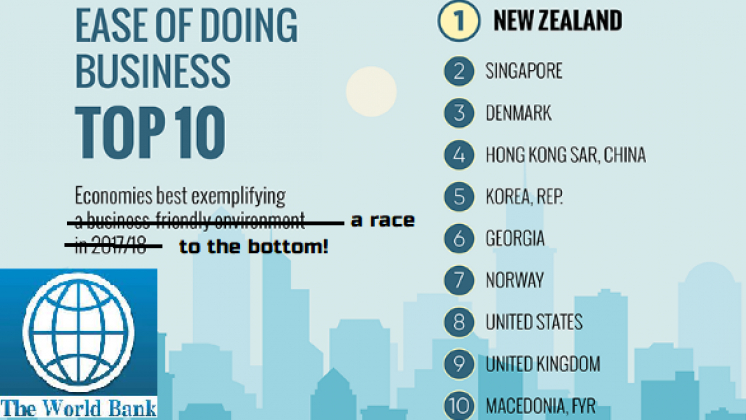Failure of Making the World in its Own Neoliberal Image
As God created man in his own image, the globalist international financial organizations similarly created and projected the world around their neoliberal agenda - represented among other key tools and instruments at their disposal - by a variety of so-called “standard-setting” governance indicators. The ideological defeat of the globally imposed neoliberal agenda, marked by its failure to acquire a resemblance of legitimacy for its crushing of the world’s nations, states and economies, now it seems to show on every facet of its global governance systems, such as in the case with the recent cancellation by the World Bank of its Doing Business indicators database. I’m sure that the scrapping of the database that ranked all countries in terms of their business environment has come as a huge shock to many transnational companies as well as governments around the world that willingly or reluctantly had to worship the neoliberal agenda that these and other indicators represented, projected and demanded to be implemented.
These indicators, however, were always suffering from both intrinsic technical and statistical problems, as well as wits issues concerning their use and their policy implications that have affected the lives of billions. Hence, the reasons for the failure of these sets of indicators are two-fold. One is the technical and based on the imperfect data collection, aggregation, and the failure of the indicators and rankings to capture what they were designed to capture. The other and more profound reason is simply their ideological bias since they didn’t measure real development but the diminishing role of the nation-state in managing its own affairs and opening of the borders for the global transnational companies. Hence, the other sets of indicators are set to fail since they suffer from the same malaise as the Doing Business (DB), on both technical and ideological grounds: the World Bank‘s World Governance Indicators (WGI), Transparency International‘s Corruption Perceptions Index (CPI), Polity IV, International Risk Group Indicators (ICRG), The UN Human Development Index, Freedom House‘s Freedom in the World, The Global Competitiveness Report, etc.
The governance indicators, frequently used by researchers, academics, businesses and policymakers, were supposed to capture the state of governance, institutions, political and economic freedoms and progress, defining them tightly around the basic ideological foundations of neoliberalism: laissez-faire, free markets, electoral democracy, economic and trade openness, human rights, etc. Many of them came into existence in the 1980ies and 1990ies with the neoliberal agenda becoming the predominant ideology prescribed by the Bretton Woods institutions and western governments as a universal panacea to all countries and have become a model to strive towards for many governments across the world.
Why are such indicators important?
The main purpose of such governance indicators is for the global investors and Transnational Corporations to justify their investment decisions, and for the international organisations and donors to base their allocation of aid., Finally, and not least important, for the media to whip up support and “moral justification” of the decisions made by the global elite. The squabbling in their desire to reach the coveted No.1 spot and attempt to influence the DB rankings - that the author of this text has witnessed first-hand - by Singapore and Hong Kong, both city-states and former colonies, not very well recognized for their democratic credentials, illustrates the importance that the global rankings according to these indicators has acquired in the last couple of decades.
Hence, it is important to note that beyond the aim of measurement, the more profound and damaging role of these indicators was their “standard-setting” role as a final neoliberal frontier to strive towards, often accompanied by arm-twisting of the unwilling national governments by the international organizations and TNCs. Under these circumstances, in essence, the bragging rights of improved indicators for any government would entail: We sold out our people more, we opened our borders more for the TNCs to crush our domestic industries, we made the taxes lower for them, we cut our budgets and social programs, we sold out more of our natural resources, we made it easier for employees to be fired – or using the code word for it – making more flexible labour laws for TNCs.
Why did they fail? Common technical problems with the indicators
Regrettably, there are too many recorded cases of bias in both the collection and interpretation of statistical data for the governance indicators (Lopes, 2012). In many cases, the governance indicators represent aggregated indexes that lump together in one observation number of different social, economic and, political factors, often lacking clarity of the methodology used. The key criticism is that the model for aggregation of so many varied data sources doesn’t link well with the reality on the ground, the so-called construct validity of the aggregation model.
Another problem is the sample heterogeneity where, for example, the Worldwide Governance Indicators (WGI) - a set of six aggregate indicators developed by the World Bank and drawn from 194 different measures, (Kauffman, Kraay & Mastruzzi, 2007) - uses input variables for aggregating the ranking of each country that vary between only 3 inputs for some and up to 34 inputs for others. This coupled with the WGI team estimates that for 30% of the countries the standard error of the ranking is as high as over 25%, makes any nuanced comparison and rankings meaningless. And as it happens, these errors mostly affect the countries for which not full data for WGI is available, the developing countries. Despite this, the practice of ranking every adjacent country ends up emphasizing imaginary differences between countries as if they were distinct and real, making the indicators poor guides for policies as each link between indicators and scores is noisy and uncertain, but presented as certain (Hoyland, Moen, Willumsen, 2009).
Similarly, the World Bank most popular database on business regulations, Doing Business Indicators - that is ranking countries in different areas of business regulations by the time and cost of the procedures required for businesses to perform - was always short of being a true measure of the country’s real business environment improvements. The author of this text has conducted number of surveys of local entrepreneurs in developing countries that were seen as darlings of the international communities and were marked as top-reformers, only to find out that the national companies say that while all these improved rankings are good, they don’t feel any difference in conducting their daily business. For example, one of the 10 DB indicators is the time needed to set up a company, which over the years was brought down to only one day, few hours and then to less than an hour, leading to the question many were asking: what difference to the real development and growth such indicator makes, except encouraging artificial, short-term and narrow quasy-reforms that have no real impact on development.
Another key issue is that the respondents of surveys - used in producing the perception-based composite indicators – are automatically assumed to be neutral and independent (Lopez-Claros et. al., 2006). Expert assessments as the source of reliable data have been criticised because experts’ views could be influenced by other experts and by other third parties and events, known as a “herd effect” (Arndt & Oman, 2006). Serious problems of the expert assessments derive from the lack of transparency, with often unclear who exactly the “experts” are.
Yet another myth is that these indicators are proving the link that democratization leads to better economic outcomes. La Porta criticizes the governance indicators such as ICRG and Polity IV indicators as not being highly correlated with the level of political reforms or democracy per se, undermining their own neoliberal fundamental ideological claims. Indeed, the country that often receives the highest score in the world is Singapore, a state known for its one-party rule. However, what leads to high ranking is this party’s chosen respect for private property and investment by TNCs, since this is of the highest importance for the neoliberal standard-setters, under the thin veil of rule of law or democratization.
The neoliberal bias of global indicators and the need for realistic non-ideological indexes
To conclude with the most important shortcoming, previously only occasionally raised but now acquiring more open and wide recognition by the researchers and policymakers - that of the neoliberal bias of such standard-setting indicators, and what should eventually come in their place after their demise. The growing resistance on part of developing countries to the use and impact of these indicators, due to them being perceived as Western and primarily used by outsiders, has been noted by a number of researchers (Arndt, 2008; Chang 2010; Lopes 2012). Similarly, an OECD survey in 2008 noted the forced imposition of the policies on developing countries by “donors and investors that fail to build on country systems or harmonise with them, having little interest in really learning about the links between governance indicators and development outcomes”. However, only now the previously widely ignored “western bias” becomes apparent, and in its true form, as a narrower and purely neoliberal bias.
For Chang (2010) the existing indicators are constructed by the Anglo-American institutions (e.g., the World Bank, commercial information providers, the Heritage Foundation, the World Economic Forum) that have inherent biases towards free-market neoliberal policies. Given their inclinations, they do not try to identify and measure institutions and governance that may help growth and development but do not fit into the liberalization narrative – for example, the welfare state, or other ideologies and other paths to development. Deliberately leaving out of the neoliberal indicators’ universe these other successful approaches that promote growth and development in many countries, leads to a biased picture of how the neoliberal and other approaches compare in promoting growth and development.
While the current media focus is on the politicizations of the DB indicators by the World Bank and according to the Wall Street Journal, concerning the data from China, Azerbaijan, the UAE, and Saudi Arabia that appeared to have been deliberately altered for political reasons, the core shortcoming is that these standard-setting neoliberal indicators are profoundly at default at capturing and promoting real sovereign and equitable development. They are solely focusing on reducing the mandates of the nation-states to manage their own affairs and flattening the world for the global corporations, thus serving as an imaginary ideal neoliberal frontier for governments to engage in the race to the bottom in relinquishing further their sovereignty and citizens’ welfare to the global corporations and institutions.
The demise of the World Bank’s DB and other indicators as totems of neoliberalism for worshipping by the governments across the world is paralleled with the need to develop a number of more realistic economic, social, and statistical indicators that can help us understand the importance of real economic, political and social development of nations in the new multipolar order un-constricted by globally prescribed ideology. This opens up new perspectives on how we can see and interpret the world around us, helping us to think and work outside the current neoliberal straightjacket towards designing, implementing, capturing, measuring, and promoting the real development of the nations. The other measures such as the Gini coefficient of inequality, and the more recent Ease of Living and the Happiness indexes, represent important breakthroughs into taking into account the community, wellbeing of nations, equality, and equity in both factual indicators and citizens’ own perception of them. Any potential and subsequent global sets of indicators should follow that lead and further develop the wider vision of the notion of development, something that was deliberately obscured, partly by the current neoliberally-biased sets of indicators whose credibility is disintegrating in front of our eyes.
References:
Hoyland, B., Moene, K., Willumsen, F., (2009). ‘The tyranny of international index rankings’ Research Programme on Democracy, Democracy as Idea and Practice.
Kaufmann, D., Kraay, A., Mastruzzi, M., (2007). 'The Worldwide Governance Indicators Project: Answering the Critics', The World Bank, Washington, D.C.
La Porta, R., Lopez-de Silanes, F.L., Shleifer, A., & Vishny, V.W. (1999). The quality of government. The Journal of Law, Economics, and Organization.
Arndt, C., Oman, C., (2006). ‘Uses and Abuses of Governance Indicators’ OECD Development Centre, OECD.
Arndt C., (2008). 'The Politics of Governance Ratings', International Public Management Journal, vol. 11, no. 3.
López-Claros, A., Altinger, L., Blanke, J., Drzeniek, M., & Mía, I. (2006). Assessing Latin American competitiveness: Challenges and opportunities. The Latin America competitiveness review.
OECD DAC, (2008). 'Survey of Donor Approaches to Governance Assessment', Organisation for Economic Cooperation and Development (OECD), Paris.
Chang, Ha-Joon (2010), “It’s time to reject the Washington Consensus,” The Guardian, 9 November, 2010.
Chang, H.J. (2010). Hamlet without the Prince of Denmark: How Development Has Disappeared from Today’s “Development” Discourse
Lopes, C., (2012). “Economic Growth and Inequality: The New Post-Washington Consensus”, RCCS Annual Review.














